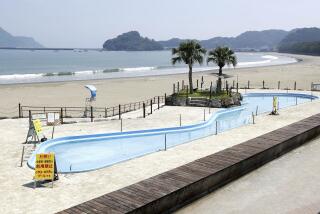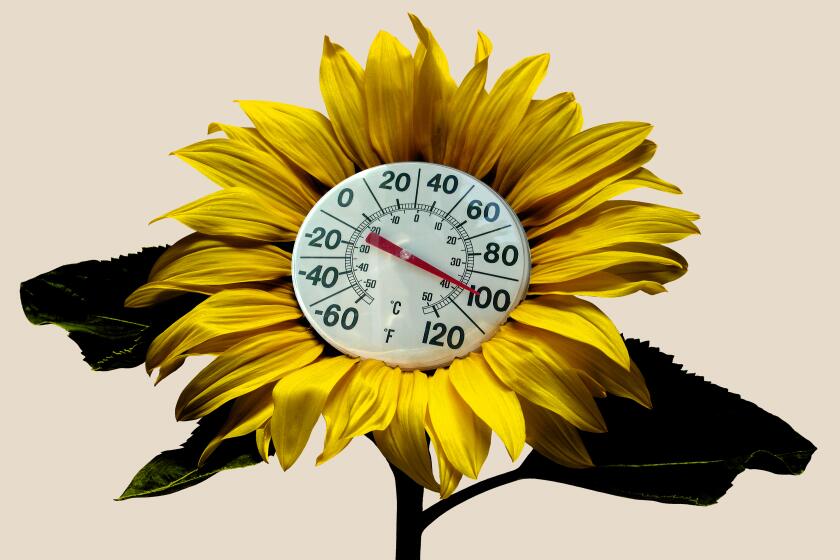Japan radiation risk to California is downplayed
Within days, nuclear radiation released from Japan’s damaged Fukushima reactors could reach California, but experts say the amount that makes its way across the ocean should pose no danger.
“What we’re being told is that there is no threat to California at this time,” said Mike Sicilia, a spokesman for the California Department of Public Health. “It’s a matter of distance. Dangerous radioactivity could not cross the 5,000 miles of the Pacific without petering out.”
The reassurances came as California and federal health officials opened hotlines to field questions about possible radiation risks. Environmental Protection Agency officials, who monitor radiation levels in air, milk and precipitation, said Tuesday that they plan to send additional staff to the Western U.S.
Photos: Scenes of earthquake destruction
Potassium iodide pills — used to prevent the body from absorbing radioactive iodine — have sold out at numerous stores despite warnings from health officials that the pills were unnecessary and could even have harmful side effects.
David McIntyre, a spokesman for the Nuclear Regulatory Commission in Washington, said his office was working Tuesday with the National Oceanic and Atmospheric Administration “to project the jet stream and the path that any radiation might take.”
The Department of Energy activated its atmospheric radioactivity monitoring center at Lawrence Livermore National Laboratory in the Bay Area to create sophisticated computer models of how radioactive releases at Fukushima will spread into the atmosphere, according to a high-ranking energy department official. But he cautioned that “we’ve got to get good data to put into it for it to be a reliable predictor and basis for people entrusted with public safety to make decisions.”
Even without detailed data, some experts said the radiation in Japan posed little danger to the U.S.
Tony VanCuren, an atmospheric scientist with the California Air Resources Board in Sacramento, said it would take a “catastrophic release” of radiation to carry dangerous levels across the ocean, and even then it would take five to 15 days for particles to reach California.
Bill Patzert, a climatologist at the Jet Propulsion Laboratory in La Cañada Flintridge, contrasted the problems at Fukushima with the Chernobyl disaster in 1986 in the Ukraine, where a massive blast drove radioactive debris into the air and around the globe.
“If we had multiple Chernobyl-type failures and it did go five to eight miles into the atmosphere and get into the jet stream, it could definitely impact the West Coast of the United States and Canada,” Patzert said. “But we’re not there yet.”
After the explosions and fire, the Fukushima nuclear complex released radiation of up to 400 millisieverts per hour, Japanese officials have said. That would be about 20 times the annual exposure for some nuclear industry workers.
Dr. James Thrall, radiologist-in-chief at Massachusetts General Hospital in Boston and president of the American College of Radiology, said anything more than about 50 millisieverts may be cause for alarm, including the use of potassium iodide pills to mitigate exposure. Studies conducted after the atomic bombing of Japan during World War II showed those exposed to 50 millisieverts or more of radiation were at increased risk for leukemia and cancer, Thrall said.
California Department of Public Health officials have advised anyone with radiation-related questions to call (916) 341-3947. As of Tuesday, the state hotline had received at least 200 calls, mostly from people afraid of radiation exposure, many trying to buy potassium iodide pills.
“That’s very concerning to us because you really should not take that without professional advice,” Sicilia said, or, “unless you are within the zone of the nuclear event,” the 12-mile radius surrounding Fukushima that already has been evacuated.
Lee Cantrell, director of the San Diego division of the California poison control system, said he had been “bombarded with calls since Sunday” from people wanting to know if they should be taking potassium iodide. In Los Angeles County, Dr. Jonathan E. Fielding, the county’s public health chief, said he has heard stocks in many pharmacies are “very low or running out.”
Fielding, in a news conference Tuesday, said his office has checked local government stockpiles of potassium iodide. If risk of radiation exposure became an issue, Fielding said, “there would be plenty of warning and opportunity to obtain the medication.”
Despite efforts to allay concerns, California customers flocked to Troy Jones’ online store for “nukepills.” Jones, who took five new orders while talking to a reporter, said he went from selling $1,000 worth of potassium iodide a week to six figures in sales during the last two days.
The Vitamin Station in Simi Valley was among those sold out.
“They did it during Chernobyl. They’re doing it again,” said Lonnie August, who opened the shop 29 years ago. “Everybody’s out of it everywhere. People worry and panic about things.”
Photos: Scenes of earthquake destruction
molly.hennessy-fiske@latimes.com
More to Read
Sign up for The Wild
We’ll help you find the best places to hike, bike and run, as well as the perfect silent spots for meditation and yoga.
You may occasionally receive promotional content from the Los Angeles Times.











